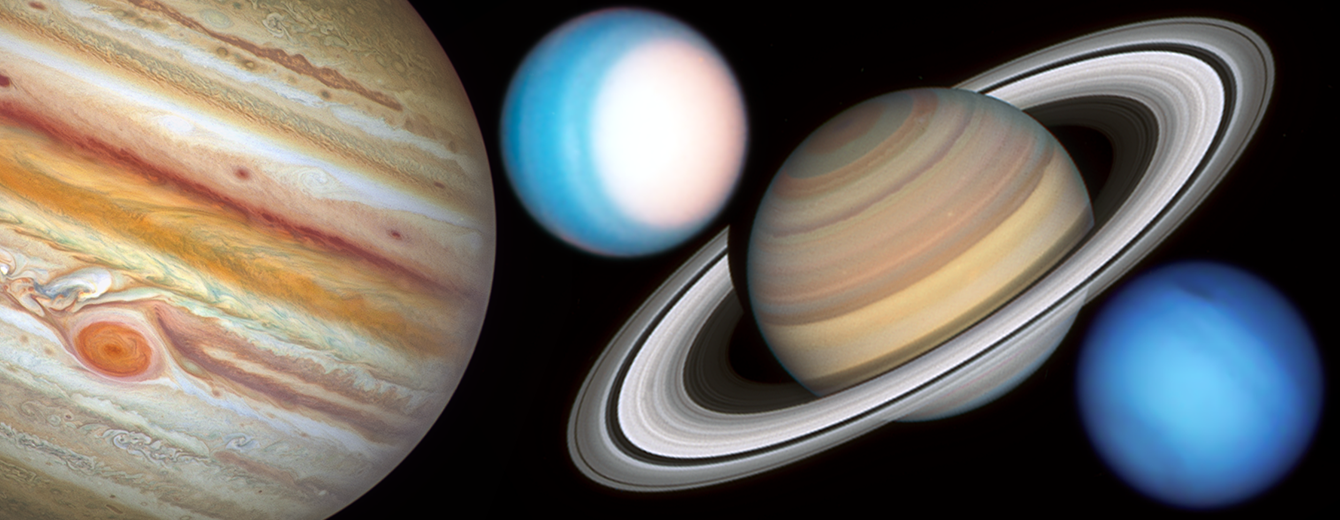When a medium-sized star begins to die, it sheds its outer layers forming a shell of gas and dust called a “planetary nebula,” but the term is misleading. It comes from late eighteenth century astronomers who thought their rounded shape looked similar to the planet Uranus, discovered in 1781. They named them “planetary” nebulas as a result.

Before the launch of Hubble in 1990, ground-based images suggested that planetary nebulae have simple, spherical shapes. Hubble observations revealed unprecedented details that show they are much more varied and complex. Some planetary nebulae look like pinwheels, others like butterflies, and still others like hourglasses. The extraordinary level of detail offers astronomers insights into the complex dynamics that accompany a star’s release of its outer gaseous layers before it collapses to form a white dwarf or neutron star.

In 2017, Hubble observed the remnants of an explosion caused by two surviving cores of two massive neutron stars that crashed into each other. The neutron stars collapsed into a black hole that began pulling material toward it. That whirlpool of material formed a rapidly spinning disk that generated blowtorch jets of radiation at nearly the speed of light. Hubble looked at the event just two days after the collision, allowing astronomers to measure the motion of a blob of material propelled by one of the jets slamming into it.
NASA, ESA, R. Kirshner (Harvard-Smithsonian Center for Astrophysics and Gordon and Betty Moore Foundation), and P. Challis (Harvard-Smithsonian Center for Astrophysics)

Learn More
Hubble Science Highlights
Discover the breadth and depth of Hubble's exciting discoveries!

Studying the Planets and Moons
Hubble’s systematic observations chart the ever-changing environments of our solar system's planets and their moons.

Tracking Evolution in the Asteroid Belt
These conglomerates of rock and ice may hold clues to the early solar system.

Uncovering Icy Objects in the Kuiper Belt
Hubble’s discoveries helped NASA plan the New Horizon spacecraft’s flyby of Pluto and beyond.

Exploring the Birth of Stars
Seeing ultraviolet, visible, and near-infrared light helps Hubble uncover the mysteries of star formation.

Finding Planetary Construction Zones
Hubble’s sensitivity uncovers the seeds of planets in enormous disks of gas and dust around stars.

Recognizing Worlds Beyond Our Sun
Hubble can detect and measure the basic organic components for life on planets orbiting other stars

Seeing Light Echoes
Like ripples on a pond, pulses of light reverberate through cosmic clouds forming echoes of light.

Tracing the Growth of Galaxies
Hubble's Deep Field observations are instrumental in tracing the growth of galaxies.

Galaxy Details and Mergers
Galaxies evolve through gravitational interaction with their neighbors, creating a menagerie of forms.

Monster Black Holes are Everywhere
Supermassive black holes lie at the heart of nearly every galaxy.

Homing in on Cosmic Explosions
Hubble helps astronomers better understand and define some of the largest explosions in the universe.

Discovering the Runaway Universe
Our cosmos is growing, and that expansion rate is accelerating.

Focusing in on Gravitational Lenses
Gravitational lenses are 'Nature's Boost', expanding our view deeper into space and farther back in time.

Shining a Light on Dark Matter
The gravitational pull of dark matter guides the formation of everything we can see in the universe.

Mapping the Cosmic Web
Filaments and sheets of matter create an interconnected web that forms the large-scale structure of the universe.




